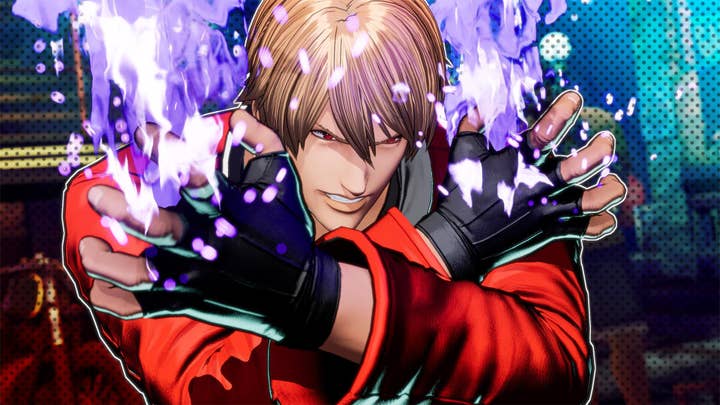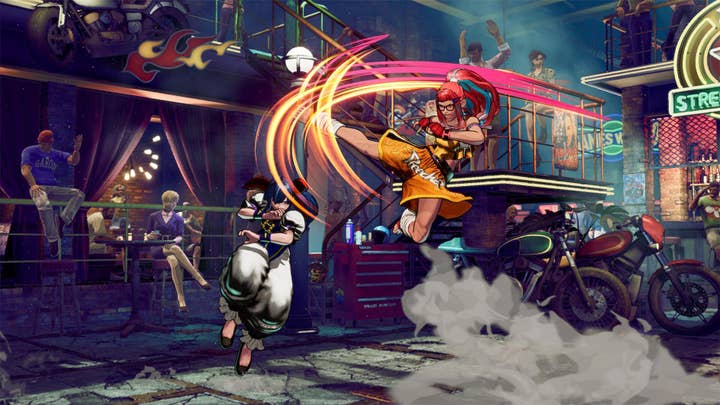The Fatal Fury combating game sequence stretches all the way in which again to 1991, when SNK Company launched Fatal Fury: King of Fighters for arcades. The franchise had quite a few iterations within the 90s, with Garou: Mark of the Wolves (1999) being the final – a minimum of till now. A quarter of a century after Mark of the Wolves got here out, we discover ourselves sitting in SNK’s sales space on the Tokyo Game Present, eagerly enjoying the upcoming Fatal Fury: Metropolis of the Wolves.
It goes with out saying that 25 years is a very long time to attend for a mainline entry in a combating game sequence, however maybe it’s properly price it. In spite of everything, we have seen the resurgence of mainline titles from SNK, similar to 2019’s Samurai Shodown and 2022’s The King of Fighters 15. This revival of dormant SNK franchises is led by none apart from Yasuyuki Oda, the producer of these two video games, in addition to the upcoming Fatal Fury: Metropolis of the Wolves.
After enjoying the demo, we sit down with Oda to study in regards to the new options, character design, aggressive play, and, naturally, why it took so lengthy to see a new Fatal Fury title.
“I wished to develop [a new Fatal Fury game] earlier however we bought tied up with different tasks,” Oda tells GamesIndustry.biz. “Nonetheless, bringing again Fatal Fury was at all times within the playing cards and it was simply a matter of discovering the fitting timing. After a number of profitable video games using different SNK IPs, it was probably the most pure subsequent selection, because it was at all times one of the cornerstones of the corporate. It’s simply purely coincidental that it’s been over 25 years because the final launch.”
Given the massive hole between the 2 releases, there needed to be some challenges alongside the way in which. Oda cites that their crew, SNK Studio 1, has at all times been composed of the unique Fatal Fury crew members. In addition they reached out to former builders who at the moment are working freelance to assist with the undertaking, successfully bringing the band again collectively.
Nonetheless, Oda admits that one of the most important challenges was the information hole between the veteran Fatal Fury crew members and youthful workers, particularly with game design and gameplay techniques.
“Loads of time was spent bridging that hole. Throughout that course of, either side realized a lot from one another which was a very fascinating expertise basically.”
Fatal Fury: Metropolis of the Wolves options visually beautiful character fashions, nearly akin to vivid designs from a comedian ebook, duking it out on a 2D aircraft. Oda cites that Fatal Fury video games had been initially meant to have American comedian ebook tastes, and the crew determined to do this with right now’s expertise.
Oda provides that “the concept of a 3D fighter was by no means proposed” when brainstorming the following Fatal Fury title. It was at all times about “displaying flashy and funky strikes from the facet,” which meant a 3D enviornment would have given the mistaken impression.
Talking of characters, Mark of the Wolves noticed the introduction of an all-new solid of battlers, many of whom had been both associated to or had been pupils of fan-favorite fighters from earlier entries within the 1991 sequence and a number of follow-ups. Terry Bogard, who’s been the face of the sequence for a long time, was truly the one returning character again then.
“Bringing again Fatal Fury was at all times within the playing cards and it was simply a matter of discovering the fitting timing”
In Metropolis of the Wolves, nonetheless, Terry can be joined by fellow icon Mai Shiranui. Battlers from Mark of the Wolves additionally make their return, together with Rock Howard, Kain Heinlein, and B. Jenet. Newcomers Preecha and Vox Reaper additionally spherical out the listing.
Preecha, Oda shares, is the pupil of Joe Higashi, one of the sequence’ most iconic characters who was launched within the first game. It’s why she’s closely influenced by his muay thai kickboxing model. Vox Reaper’s design, in the meantime, is influenced by his mentor, Grant, who first appeared as a sub-boss in Mark of the Wolves. “That is why we wished him to have an agile and funky combating model,” notes Oda.
So far as returning characters are involved, Oda notes that the characters which play an necessary function within the story are those that they focus on first. Particularly, the crew appears at characters with storyline arcs which have but to be resolved.
Oda additionally differentiates between The King of Fighters and the Fatal Fury sequence. “Characters do not age in The King of Fighters as a result of time doesn’t advance, however you see them getting older in Fatal Fury. Simply as Terry has aged greater than ten years since Actual Bout 2, the introduction of different characters provides depth to worldbuilding.”

Apart from iconic fan favorites and returning combatants, the most important shock is the inclusion of Chun-Li and Ken, from Capcom’s Avenue Fighter sequence. This marks the primary time that visitor characters have been launched in SNK’s Fatal Fury video games.
Oda shares that introducing visitor characters is at all times a collaborative effort between corporations.
“[Producers and project leads] go over [the process] collectively and supervise one another. We work to give you concepts that may match into the world of every title with out destroying the character’s picture, and if there are expressions distinctive to every title. It is not quite common for us builders to come across main conflicts amongst one another.”
We additionally ask how Chun-Li and Ken match inside the general narrative arc of the sequence and if there’s a potential for extra reveals down the road. Oda, nonetheless, is tight-lipped.
“We’re making an attempt to maintain the story underneath wraps for now. We do have some issues that we’re interested by, and DLC plans within the pipeline.”
“There’s a diploma of approachability that ought to enchantment to informal followers, and sufficient complexity geared for extra hardcore gamers”
In phrases of the gameplay itself, Fatal Fury: Metropolis of the Wolves options the SPG system, which is seen as an evolution of the Tactical Offense Place (TOP) system from Mark of the Wolves, one thing Oda believes will “grant gamers extra freedom and alternatives to make tactical selections.”
“There’s a diploma of approachability that ought to enchantment to informal followers, and sufficient complexity geared for extra hardcore gamers,” Oda tells us. He provides that the crew actually desires to enchantment to each informal and hardcore participant bases.
SNK didn’t wish to water down the expertise both. The concept is to “preserve the talent ceiling excessive, however not too excessive as to exclude others.” The crew additionally feels that it’s achieved what they got down to do, balance-wise, because the title has techniques that cater to completely different combating game group crowds.
Oda notes that the corporate tries to take a “wider method” with regards to competitions and esports, particularly with its grassroots Esports Support Program that goals to assist match organizers.
“It is not simply in regards to the high 1%,” Oda says. “We wish all people around the globe to have enjoyable with native tournaments, too.”
Oda acknowledges how a lot these occasions have helped the crew. Understanding that there’s at all times some anxiousness earlier than every main launch, particularly in the event that they plan on reviving a dormant sequence, “it’s the reception from occasions around the globe which have constructed up our crew’s confidence.”

As we’re about to finish our dialog, we ask Oda how a lot issues have modified since he first began within the business in 1993.
“Once I joined SNK in 1993, it was for [debug work] on Fatal Fury Particular,” Oda tells us, as if working on Fatal Fury: Metropolis of the Wolves is like a full circle second. “Again then, our small crew was centered on growing video games for arcade platforms and the Neo Geo, and nobody was interested by porting video games to different consoles. The surroundings then was utterly completely different than it’s right now. As the size of growth grows, it turns into extra necessary to take care of more and more complicated administration, and I believe it’s going to not be attainable to develop video games with simply a few acquaintances like previously.”
“I believe it’s going to not be attainable to develop video games with simply a few acquaintances like previously”
Oda additionally shares extra particulars. “I began as an artist, then I went on to grow to be a director and after that a producer. I’ve skilled platforms from 16-bit machines to the present PlayStation 5. I have been a gamer because the House Invader days, so I believe my expertise as a creator and a participant has allowed me to method this undertaking properly, although I am undecided what the opposite workers round me thinks,” he laughs.
We ask if there are different plans which are nonetheless on his bucket listing. Oda jokingly tells us, “I have been within the business for over 30 years, so I do not bear in mind anymore.”
He does, nonetheless, point out that he want to make a South City motion RPG in the future, which is predicated on a location within the Fatal Fury and Artwork of Combating video games.
Talking of Artwork of Combating, this specific SNK franchise has not seen a mainline entry since 1996, although we all know that an upcoming title has been introduced. We ask Oda if he’s additionally main the revival of the franchise, and he grins within the affirmative, “Sure, I’m main the Artwork of Combating undertaking, too.”
From Samurai Shodown and King of Fighters to Artwork of Combating and Fatal Fury: Metropolis of the Wolves, Yasuyuki Oda is definitely on the forefront of SNK’s combating game sequence resurgence.
Fatal Fury: Metropolis of the Wolves is predicted to launch on April 21, 2025, for the PlayStation 4, PlayStation 5, PC, and Xbox Sequence X|S.
